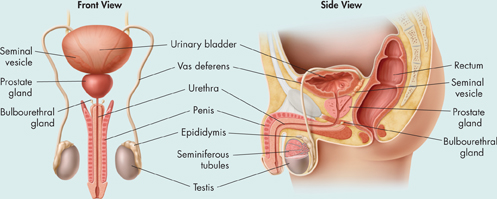The Male Reproductive System
 What are the main functions of the male reproductive system?
What are the main functions of the male reproductive system?
The release of LH stimulates cells in the testes to produce increased amounts of testosterone. Testosterone causes the male physical changes associated with puberty and, together with FSH, stimulates the development of sperm.  When puberty is complete, the reproductive system is fully functional, meaning that the male can produce and release active sperm.
When puberty is complete, the reproductive system is fully functional, meaning that the male can produce and release active sperm.
Figure 34–11 shows the structures of the male reproductive system. Just before birth (or sometimes just after), the primary male reproductive organs, the testes (singular: testis), descend from the abdomen into an external sac called the scrotum. The testes remain in the scrotum, outside the body cavity, where the temperature is a few degrees lower than the normal temperature of the body (37°C). The lower temperature is important for proper sperm development.
Sperm Development Within each testis are clusters of hundreds of tiny tubules called seminiferous (sem uh NIF ur us) tubules where sperm develop. A cross section of one tubule is shown in Figure 34–11. Specialized diploid cells within the tubules undergo meiosis and form the haploid nuclei of mature sperm. Recall that a haploid cell contains only a single set of chromosomes.
After they are produced in the seminiferous tubules, sperm are moved into the epididymis (ep uh DID ih mis), in which they mature and are stored. From the epididymis, some sperm are moved into a tube called the vas deferens. The vas deferens extends upward from the scrotum into the abdominal cavity. Eventually, the vas deferens merges with the urethra, the tube that leads to the outside of the body through the penis.

FIGURE 34–11 Male Reproductive System The main structures of the male reproductive system produce and deliver sperm. The micrograph shows a cross section of one tiny seminiferous tubule containing developing sperm (SEM 150×).
Table of Contents
- Formulas and Equations
- Applying Formulas and Equations
- Mean, Median, and Mode
- Estimation
- Using Measurements in Calculations
- Effects of Measurement Errors
- Accuracy
- Precision
- Comparing Accuracy and Precision
- Significant Figures
- Calculating With Significant Figures
- Scientific Notation
- Calculating With Scientific Notation
- Dimensional Analysis
- Applying Dimensional Analysis





